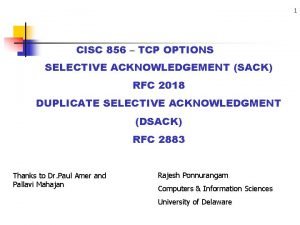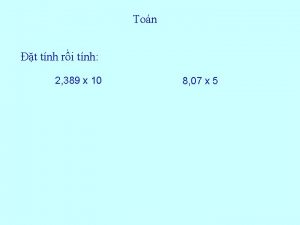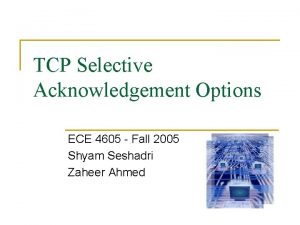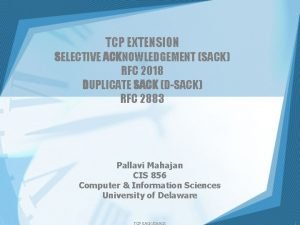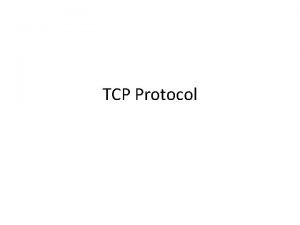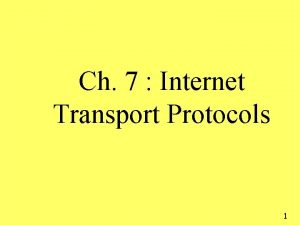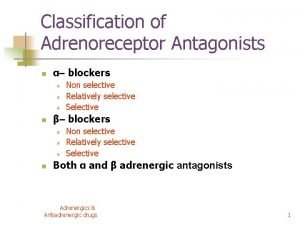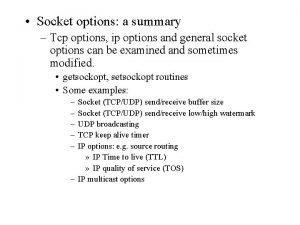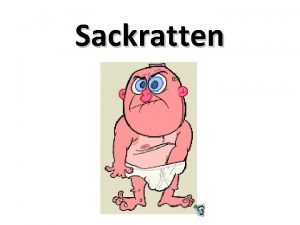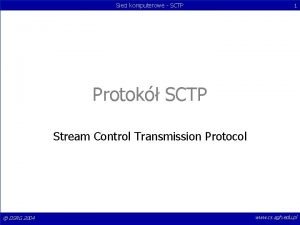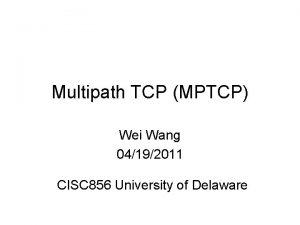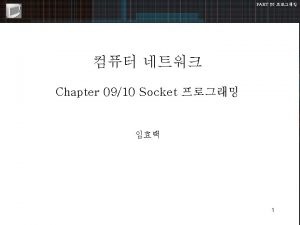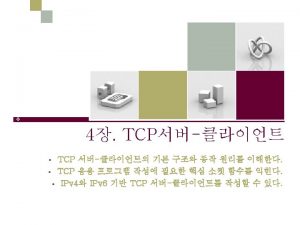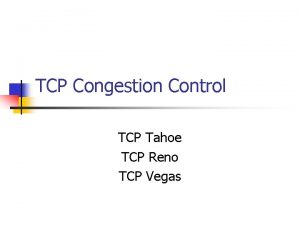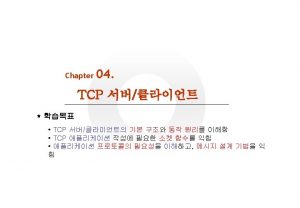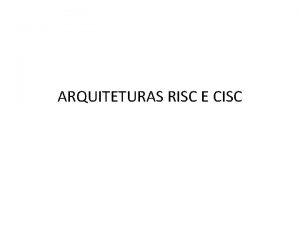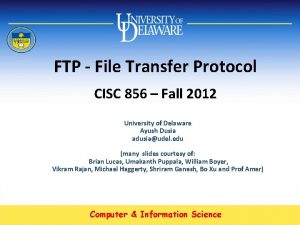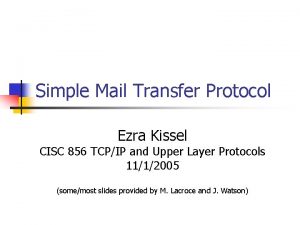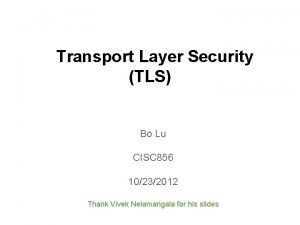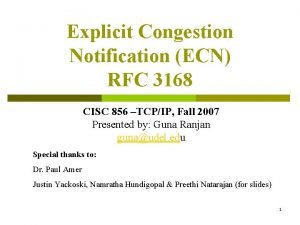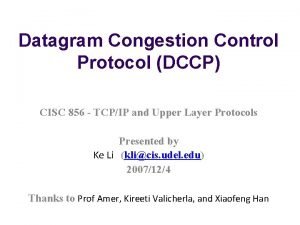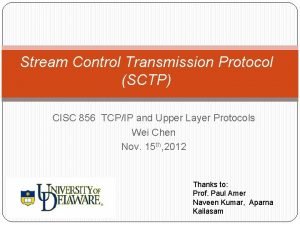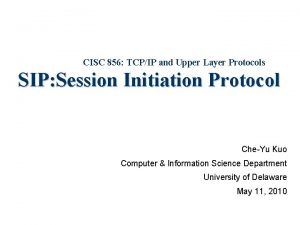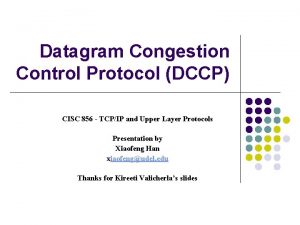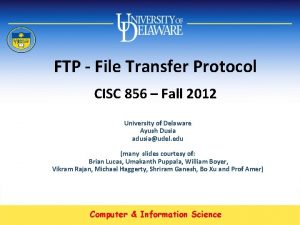1 CISC 856 TCP OPTIONS SELECTIVE ACKNOWLEDGEMENT SACK


























- Slides: 26

1 CISC 856 – TCP OPTIONS SELECTIVE ACKNOWLEDGEMENT (SACK) RFC 2018 DUPLICATE SELECTIVE ACKNOWLEDGMENT (DSACK) RFC 2883 Thanks to Dr. Paul Amer and Pallavi Mahajan Rajesh Ponnurangam Computers & Information Sciences University of Delaware

2 TCP without SACK • TCP uses cumulative ACKs • Receiver identifies the last byte of data successfully received • Out of rrder segments are not ACKed • Receiver sends duplicate ACKs • TCP without SACK forces the TCP sender • Either to wait an RTT to find out a segment was lost • Or, unnecessarily retransmit data that has been correctly received • Can result in reduced overall throughput

3 TCP with Selective Ack (SACK) • SACK + Selective Repeat Retransmission Policy allows • receiver informs sender about all segments that are successfully received. • sender fast retransmits only the missing data segments • SACK is implemented using two TCP Options • SACK-Permitted Option • SACK Option

4 SACK-Permitted Option • Sack–Permitted option • is allowed only in a SYN Segment. • indicates sender handles SACKs, and receiver should send SACKs if possible. • SACK option can be used once connection is established Source port address TCP header length Destination port address Sequence Number Cumulative Ack No. 1 6 Checksum SYN bit TCP Header kind=4 length=2 SACKpermitted Window size Urgent pointer kind=1 NOP options

5 SACK-Permitted Option and SACK RECEIVER SENDER TCP connection establishment phase “SACK-permitted” SYN/ACK SYN “SACK-permitted” Sourceportaddress Destinationportaddress Source port address Sequence Number Sequence. Destination Number port address data transfer phase SYN bit ACK bit Sequence Ack Number Cumulative Ack. No. s K C A ti 1 onal SAck p o d n Cumulative No. a Window size k c 1 1 cum a Window size Checksum Urgentpointer 1 Checksum kind=4 length=2 SACK- Urgent kind=1 pointer kind=1 NOP options

6 SACK Option Source port address Destination port address Sequence Number • Length of SACK with n blocks? = (2 + 8 * n) bytes Cumulative Ack No. HLEN Window size Checksum Kind=1 Urgent pointer Kind=5 Length=? ? Left edge of 1 st block Right edge of 1 st block Left edge of nth block Right edge of nth block • Max number bytes available for TCP Options? = 40 bytes • Max number of SACK blocks possible? = 4 SACK blocks (barring no other TCP Options)

7 SACK Example 1 - 100 receiver’s buffer ACK 201 -300 301 -400 401 - 50 0 501 - 60 0 1 -100 101 -200 receiver sender 101 - 200 1 401 -60 K C A S 1 0 2 ACK 1 -100 101 -200 401 -500 501 -600

8 SACK Rules • With SACKs, the ACK field is still a cum ACK • A SACK cannot be sent unless the SACK-Permitted option has been received (in the SYN) • The 1 st SACK block MUST specify the contiguous block of data containing the segment which triggered this acknowledgment • If SACKs are sent, SACK option should be included in all ACK’s which do not ACK the highest sequence number in the data receiver’s queue

9 Generating SACKs – data receiver behavior • If the data receiver has not received a SACK-Permitted Option for a given connection, the receiver must not send SACK options on that connection • The receiver should send an ACK for every valid segment that arrives containing new data • The data receiver should include as many distinct SACK blocks as possible in the SACK option • SACK option should be filled out by repeating the most recently reported SACK blocks • The data receiver provides the sender with the most up-to-date info about the state of the network and the receiver’s queue

10 Interpreting SACKs - Data Sender behavior • The sender records the SACK for future reference • Maintains a retransmission queue containing unacknowledged segments • One possible implementation • Turns on SACK bit for the segment in retransmission queue when it receives a SACK • Skips SACKed data during any later fast retransmission • On fast retransmit, retransmits data not SACKed so far and less than the highest SACKed data • Turns off SACK bit after retransmission time out

11 Another SACK Example Receiver Buffer 100 299 100 -299 ACK 300 -499 500 -699 700 -899 900 -1099 00 100, 500 -7 -1 0 0 9 K C A ACK 300, S 1100 -129 9 699 300 699 receiver sender CK 500 -700 A ACK 300, S 300 500 900 1099

12 Another SACK Example 300 1100 -129 9 300 -499 500 699 900 (cont’d) 1099 300 500 699 900 1099 300 500 700 900 1099 00 ACK 900 -11 ACK 700, S sender ACK 1100 receiver 700 -899 1100

13 Without SACK vs. With SACK TCP without SACK 200 -299 100 -199 ACK 200 300 -399 ACK 200 500 -599 ACK 200 sender fast retransmit receiver sender ACK 200 400 -499 0 -400 ACK 200, SACK 30 500 -599 0 -500 ACK 200, SACK 30 0 -600 fast retransmit 200 -299 200 -599 ACK 600 receiver 400 -499

14 Data Receiver Reneging – fail to fulfill a promise or obligation • Data receiver is permitted to discard data in its queue that has not been acknowledged to the data sender, even if the data has already been SACKed • Such discarding of SACKed segments is discouraged, but may occur if the receiver must give buffer space back to the OS • If reneging occurs • first SACK should reflect the newest segment even if its going to be discarded • Except for the newest segment, all SACK blocks MUST NOT report any old data which is no longer actually held by the receiver

15 Reneging Example 100 -199 200 -299 100 ACK 200 300 -399 400 -499 199 00 -400 500 -599 K ACK 200; SAC receiver sender K 3 ACK 200; SAC 200 200 500 -600 399 reneg occurs; window decreases window increases 500 599

16 Consequences of Reneging • Sender must maintain normal TCP timeouts • Data cannot be considered “communicated” until a cum ACK is sent • Sender must retransmit the data at the left window edge after a retransmit timeout, even if that data has been SACKed by the receiver • Sender MUST NOT discard data before being acked by the Cum Ack

17 SACK Observations • SACK TCP follows standard TCP congestion control; Adding SACK to TCP does not change the basic underlying congestion control algorithms • SACK TCP has major advantages when compared TCP Tahoe, Reno, Vegas and New Reno, as PDUs have been provided with additional information due to the SACK • Difference in behavior when multiple packets are dropped from one window of data • SACK information allows the sender to better decide what to retransmit and what not to

Duplicate SACK (D-SACK) Extension to SACK – RFC 2883 • How is SACK option used when duplicate segments are received? • D-SACK does not require separate negotiation between a TCP sender and receiver that have already negotiated SACK • When D-SACK is used, the first block of the SACK option should be a DSACK block specifying a duplicate segment • A D-SACK block is only used to report a duplicate contiguous sequence of data received by the receiver in the most recent segment • Each duplicate contiguous sequence of data received is reported in at most one D-SACK block 18

D-SACK Example Segment replicated by the network Receiver Buffer 200 399 200 -399 ACK 400 -599 600 -799 800 -999 ACK 600 -10 ACK 400, S receiver sender CK 600 -800 A ACK 400, S 400 600 799 400 600 800 999 00 00 -1000, 6 8 K C A S , 0 ACK 40 19

20 DSACK – Another example Receiver Buffer 500 599 500 -599 600 -699 700 -799 800 -899 900 -999 1000 -109 9 700 -89 9 0 K 1100 -120 C A S , 0 0 6 ACK 200 ACK 1100 -1 ACK 700, S 0 0 00, 1100 -12 ACK 800 -9 ACK 900, S 600 1199 600 699 1100 1199 receiver sender 1100 -1199 600 699 800 899 700 899 1100 1199

21 Interpreting D-SACK - Data Sender Behavior • The loss of a single ACK can prevent this information from reaching the sender. • How does sender knows the first SACK block is a D-SACK? • Compares the sequence space in the 1 st SACK block to the cum ACK • if seq_space < cum_ACK, then duplicate data has been received • if seq_space > cum_ACK, then sender compares seq_space with the seq_space in 2 nd SACK block (if there is one) • if the 1 st SACK block is reporting duplicate data that lies above the cumulative ACK, then the 1 st SACK block will be a subset of the 2 nd SACK block.

22 DSACK Example TCP with SACK & without D-SACK cwnd =10 200 -299 100 -199 ACK 200 300 -399 400 -499 0 -400 ACK 200, SACK 30 500 -599 0 -500 ACK 200, SACK 30 0 -600 ACK 200, SACK 30 fast retransmit ACK 600 200 -299 cwnd =5 cwnd =10 ACK 200, SACK 30 0 -600 fast retransmit ACK 600 200 -299 0 -300 ACK 600, SACK 20 receiver cwnd =5 200 -299 ACK 200 sender cwnd =5 cwnd =10 receiver sender cwnd =5 100 -199 TCP with SACK and D-SACK

23 D-SACK and Retransmissions • D-SACK allows TCP sender to determine when a retransmission was “spurious” (ie, unnecessary) and then undo congestion control measures • D-SACK allows TCP sender to determine if the network is duplicating TCP-PDUs • D-SACK does not allow a sender to determine if both the original and retransmitted data are received, or the original is lost and the retransmitted data is duplicated by the network.

24 SACK and D-SACK Interaction • There is no difference between SACK and D-SACK, except that the first SACK block is used to report a duplicate segment in D-SACK. • D-SACK does not require separate negotiation between a TCP sender and receiver that have already negotiated SACK capability. • D-SACK is compatible with current implementations of SACK option in TCP.

25 Current Implementations of SACK • Windows 2000/XP • Controlled by a registry parameter – Sack. Opts in “HKEY_LOCAL_MACHINESYSTEMCurrent. Control. SetServicesTcpipPa rameters” - Sack. Opts="1" • Windows Vista • Windows Server 2008 and Windows Vista support TCP SACK • Free BSD and Net. BSD have optional modules • Solaris 7 and later

26 References • RFC 2018 – TCP Selective Acknowledgement Options. • RFC 2883 – An Extension to SACK option for TCP. • Kevin Fall and Sally Floyd, “Simulation-based Comparisons of Tahoe, Reno, and SACK TCP”, Lawrence Berkley National Laboratory.
 Tcp selective acknowledgement
Tcp selective acknowledgement Drg 856
Drg 856 2 phẩy 389 x 10
2 phẩy 389 x 10 Selective acknowledgement
Selective acknowledgement Selective acknowledgement
Selective acknowledgement Tcp header
Tcp header What is duplicate acknowledgement in tcp
What is duplicate acknowledgement in tcp Arrethmia
Arrethmia Tcp socket options
Tcp socket options How much work is done in holding a 15 n sack of potatoes
How much work is done in holding a 15 n sack of potatoes Sackraten
Sackraten Hoopy portal
Hoopy portal A sack slides off the ramp
A sack slides off the ramp Sctp tsn
Sctp tsn Kleophrades painter
Kleophrades painter Elder trojan prince
Elder trojan prince Beleidigungen für jeden anlass
Beleidigungen für jeden anlass How to make a flour baby
How to make a flour baby Male einen sack kartoffeln und singe ein lied dazu
Male einen sack kartoffeln und singe ein lied dazu Kleophrades hydria
Kleophrades hydria Paris vs vikings
Paris vs vikings Dewatering super sack
Dewatering super sack Wcag silver
Wcag silver Computer organization and architecture definition
Computer organization and architecture definition Cisc cu boulder
Cisc cu boulder Cisc processor
Cisc processor Cisc vs risc
Cisc vs risc
